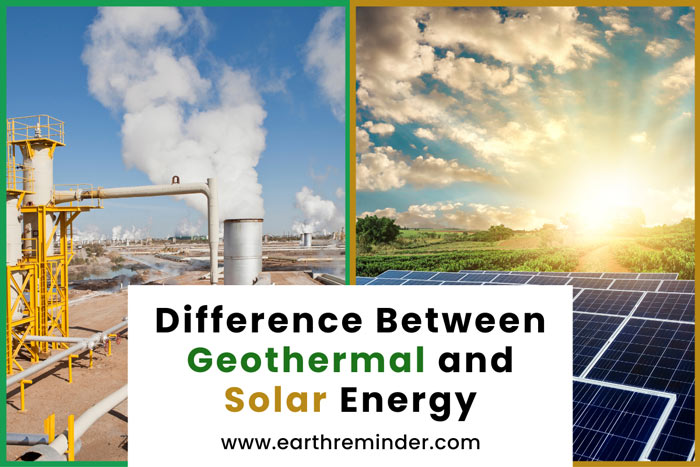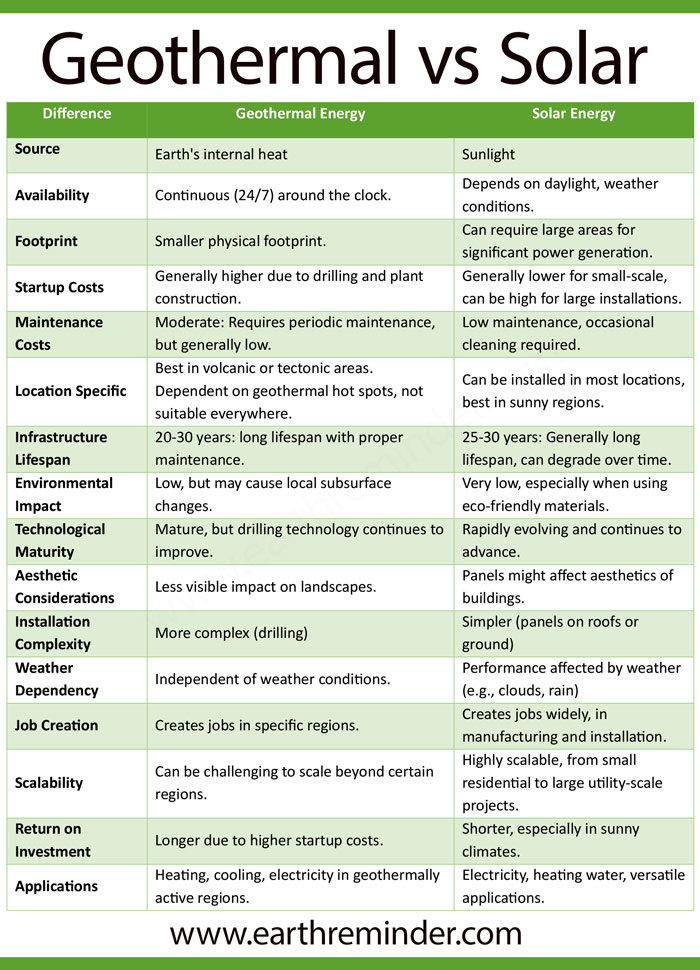Geothermal vs Solar: 15 Key Differences
Many places around the world are looking for clean ways to make electricity because burning fuel harms our planet. Geothermal and solar energy are two different ways to get power from the Earth and the sun. They are both renewable, but they’re used very differently. Solar uses light from the sun to make electricity, while geothermal utilizes heat from deep inside the Earth. Both of them can help us to reduce dependence on fossil fuels that pollutes the environment. Here, we will look at geothermal energy vs solar to compare their benefits and limitations.
Table of Contents
Introduction to Geothermal Energy
Geothermal energy is the heat that comes from inside the Earth. This heat comes from deep down where there is a hot, melted rock called magma. We can use this heat as energy by drilling holes deep into the ground and sending water down these holes. When water goes down these holes, it turns to steam because of the heat. This steam can make electricity through machines called turbines. One of the greatest benefits of geothermal energy is that it’s clean and doesn’t create pollution. Also, it’s always available, whenever we need it. Still, there are some challenges. Some places on Earth don’t have enough heat to use, and drilling deep into the Earth can be expensive especially the initial setup cost.
Introduction to Solar Energy
Solar energy is power that comes from the sun, which we can use in many different ways. It is a very clean type of energy, i.e., it doesn’t pollute the air or contribute to climate change. It’s captured using solar panels, which are generally placed on rooftops or large fields. These panels contain solar (photovoltaic) cells made from special materials called semiconductors. A few examples are silicon, thin-film, and perovskite, which help to convert sunlight into electricity. You can use the electricity immediately or store it in batteries to use later when you need it. Solar energy is getting more popular as technology improves because solar panels are becoming cheaper and more efficient at capturing sunlight.
Comparison: Geothermal vs Solar
The difference between geothermal and solar energy is explained in the following table:
| Difference | Geothermal Energy | Solar Energy |
| Source | Earth’s internal heat | Sunlight |
| Availability | Continuous (24/7) around the clock. | Depends on daylight, and weather conditions. |
| Footprint | Smaller physical footprint. | Can require large areas for significant power generation. |
| Startup Costs | Generally higher due to drilling and plant construction. | Generally lower for small-scale, can be high for large installations. |
| Maintenance Costs | Moderate: Requires periodic maintenance, but generally low. | Low maintenance, occasional cleaning required. |
| Location Specific | Best in volcanic or tectonic areas. Dependent on geothermal hot spots, not suitable everywhere. | Can be installed in most locations, best in sunny regions. |
| Infrastructure Lifespan | 20-30 years: long lifespan with proper maintenance. | 25-30 years: Generally long lifespan, can degrade over time. |
| Environmental Impact | Low, but may cause local subsurface changes. | Very low, especially when using Eco-friendly materials. |
| Technological Maturity | Mature, but drilling technology continues to improve. | Rapidly evolving and continues to advance. |
| Aesthetic Considerations | Less visible impact on landscapes. | Panels might affect the aesthetics of buildings. |
| Installation Complexity | More complex (drilling) | Simpler (panels on roofs or ground) |
| Weather Dependency | Independent of weather conditions. | Performance affected by weather (e.g., clouds, rain) |
| Job Creation | Creates jobs in specific regions. | Creates jobs widely, in manufacturing and installation. |
| Scalability | Can be challenging to scale beyond certain regions. | Highly scalable, from small residential to large utility-scale projects. |
| Return on Investment | Longer due to higher startup costs. | Shorter, especially in sunny climates. |
| Applications | Heating, cooling, and electricity in geothermally active regions. | Electricity, heating water, versatile applications. |
To compare geothermal vs solar further, we will look more into their benefits and limitations below:
Benefits of Geothermal Energy
- Consistent: Geothermal energy is always available, 24/7 irrespective of weather conditions. It doesn’t depend on the sun or wind, so it’s always working. Because of this, it’s quite reliable. It works all the time, whereas solar or wind power, which might not work as the weather changes.
- Low Emissions: Geothermal energy doesn’t emit a lot of harmful gases into the air. These are the gases that cause issues like global warming and pollution. Using geothermal energy instead of coal and oil will keep the air cleaner and fight climate change.
- Efficient: Energy efficiency means we can do more with less. Using geothermal energy can give you a lot of power without wasting much of it. This works even better in places where there’s a lot of heat inside the Earth (called “hotspots”). By using fewer resources, we can save money and help the environment.
- Smaller Footprint: There’s no need for a lot of space for geothermal energy. You’ll need a big field for a solar farm, but a geothermal plant can be much smaller. Geothermal energy uses less land, so there’s more space for nature. When land is precious or difficult to acquire, it’s a good option.
Benefits of Solar Energy
- Abundant Source: Sunlight is everywhere, so almost every place can make energy from it. There’s no limit to the supply of energy, compared to fossil fuels, which can be expensive and limited.
- Decentralization: You can put solar panels on the roof of your house or buildings. This way, you can make energy right where you need it. Moving energy close to its destination reduces energy loss through wires. This makes it more efficient and saves you money.
- Low Maintenance: When you install solar panels, they don’t need a lot of maintenance. Less work means less repair and maintenance. They’re good for people who don’t want to spend a lot of time maintaining them.
- Cost Decline: Solar panels are getting cheaper and cheaper over time. People can now afford solar energy as the costs go down. It helps the environment and saves people money.
Also Read: Why Is Solar Energy Better for The Future?
Limitations of Geothermal Energy
- High initial costs will be associated with the drilling and setup of the plant.
- It’s mainly effective near geothermal hotspots and tectonic plate boundaries.
- There is a possibility of a geothermal reservoir becoming depleted if poorly managed. It usually happens when people bring up hot water from underground faster than it can be replenished by nature.
Limitations of Solar Energy
- The solar energy process depends on sunlight, so on cloudy or rainy days, there will be less light available to generate electricity.
- There is a significant requirement for land to build large solar farms.
- Battery solutions are required for energy storage so that power can be supplied continuously.
Economic Analysis
When looking at geothermal vs solar, the initial costs of geothermal plants may be high, but their consistent output and direct heating are beneficial advantages that will pay off in the long run. Solar energy, especially in sunny places, offers a strong economic advantage due to its falling panel prices and tax incentives.
Environmental Impacts
If geothermal plants aren’t managed right, they can cause localized environmental issues, like minor seismic activity. But they have a small carbon footprint. As for solar panels, they have a very low environmental impact, especially when you consider the emissions over their lifetime.
Future Prospects
Geothermal and solar energy are likely to get more efficient and reach more people through technological advances. There’s an opportunity to make geothermal energy more accessible in more places with Enhanced Geothermal Systems (EGS). Improvements in solar technology can lead to improved solutions for capturing and storing solar energy.
Also Read: The Future Of Geothermal Energy.
Conclusion
Both geothermal and solar energy have unique strengths when we compare geothermal vs solar. While geothermal offers consistent energy, solar’s decentralization and falling costs make it a good choice. Geothermal works best near tectonic plate boundaries, with a high upfront cost but low operation costs. With solar energy, you depend on the weather and the time of day, but it’s cheap to install and can be placed anywhere. Both are good for the environment compared to fossil fuels. The mix of these renewable sources will be the key to a sustainable future. Also, before choosing an energy solution, please take into account local conditions, government incentives, and energy requirements.

